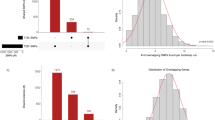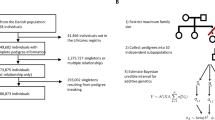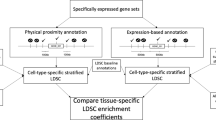Abstract
Two issues regarding the robustness of the original transmission disequilibrium test (TDT) developed by Spielman et al are: (i) missing parental genotype data and (ii) the presence of undetected genotype errors. While extensions of the TDT that are robust to items (i) and (ii) have been developed, there is to date no single TDT statistic that is robust to both for general pedigrees. We present here a likelihood method, the TDTae, which is robust to these issues in general pedigrees. The TDTae assumes a more general disease model than the traditional TDT, which assumes a multiplicative inheritance model for genotypic relative risk. Our model is based on Weinberg's work. To assess robustness, we perform simulations. Also, we apply our method to two data sets from actual diseases: psoriasis and sitosterolemia. Maximization under alternative and null hypotheses is performed using Powell's method. Results of our simulations indicate that our method maintains correct type I error rates at the 1, 5, and 10% levels of significance. Furthermore, a Kolmorogov–Smirnoff Goodness of Fit test suggests that the data are drawn from a central χ2 with 2 df, the correct asymptotic null distribution. The psoriasis results suggest two loci as being significantly linked to the disease, even in the presence of genotyping errors and missing data, and the sitosterolemia results show a P-value of 1.5 × 10−9 for the marker locus nearest to the sitosterolemia disease genes. We have developed software to perform TDTae calculations, which may be accessed from our ftp site.
Similar content being viewed by others
Log in or create a free account to read this content
Gain free access to this article, as well as selected content from this journal and more on nature.com
or
References
Ott J : Analysis of Human Genetic Linkage. Baltimore: The Johns Hopkins University Press; 1999.
Lee MH et al: Fine mapping of a gene responsible for regulating dietary cholesterol absorption; founder effects underlie cases of phytosterolaemia in multiple communities. Eur J Hum Genet 2001; 9: 375–384.
Breslow NE, Day NE : Statistical Methods in Cancer Research. Lyon: International Agency for Research on Cancer; 1980, p350.
Falk CT, Rubinstein P : Haplotype relative risks: an easy reliable way to construct a proper control sample for risk calculations. Ann Hum Genet 1987; 51: 227–233.
Terwilliger JD, Ott J : A haplotype-based ‘haplotype relative risk’ approach to detecting allelic associations. Hum Hered 1992; 42: 337–346.
Spielman RS, McGinnis RE, Ewens WJ : Transmission test for linkage disequilibrium: the insulin gene region and insulin-dependent diabetes mellitus (IDDM). Am J Hum Genet 1993; 52: 506–516.
Laird NM, Horvath S, Xu X : Implementing a unified approach to family-based tests of association. Genet Epidemiol 2000; 19 (Suppl 1): S36–S42.
Martin ER, Kaplan NL, Weir BS : Tests for linkage and association in nuclear families. Am J Hum Genet 1997; 61: 439–448.
Ott J : Statistical properties of the haplotype relative risk. Genet Epidemiol 1989; 6: 127–130.
Julier C, Hyer RN, Davies J et al: Insulin-IGF2 region on chromosome 11p encodes a gene implicated in HLA-DR4-dependent diabetes susceptibility. Nature 1991; 354: 155–159.
Spielman RS, Ewens WJ : The TDT and other family-based tests for linkage disequilibrium and association. Am J Hum Genet 1996; 59: 983–989.
Curtis D, Sham PC : A note on the application of the transmission disequilibrium test when a parent is missing. Am J Hum Genet 1995; 56: 811–812.
Gordon D, Heath SC, Liu X, Ott J : A transmission/disequilibrium test that allows for genotyping errors in the analysis of single-nucleotide polymorphism data. Am J Hum Genet 2001; 69: 371–380.
Mitchell AA, Cutler DJ, Chakravarti A : Undetected genotyping errors cause apparent overtransmission of common alleles in the transmission/disequilibrium test. Am J Hum Genet 2003; 72: 598–610.
Sun F, Flanders WD, Yang Q, Khoury MJ : Transmission disequilibrium test (TDT) when only one parent is available: the 1-TDT. Am J Epidemiol 1999; 150: 97–104.
Lee WC : Transmission/disequilibrium test when neither parent is available in some families: a non-iterative approach. J Cancer Epidemiol Prev 2002; 7: 97–103.
Weinberg CR : Allowing for missing parents in genetic studies of case–parent triads. Am J Hum Genet 1999; 64: 1186–1193.
Gordon D, Ott J : Assessment and management of single nucleotide polymorphism genotype errors in genetic association analysis. Pac Symp Biocomput 2001; 18–29.
Douglas JA, Skol AD, Boehnke M : Probability of detection of genotyping errors and mutations as inheritance inconsistencies in nuclear-family data. Am J Hum Genet 2002; 70: 487–495.
Sobel E, Papp JC, Lange K : Detection and integration of genotyping errors in statistical genetics. Am J Hum Genet 2002; 70: 496–508.
Mote VL, Anderson RL : An investigation of the effect of misclassification on the properties of chisquare-tests in the analysis of categorical data. Biometrika 1965; 52: 95–109.
Bernardinelli L, Berzuini C, Seaman S, Holmans P : Bayesian trio models for association in the presence of genotyping errors. Genet Epidemiol 2004; 26: 70–80.
Morris RW, Kaplan NL : Testing for association with a case–parents design in the presence of genotyping errors. Genet Epidemiol 2004; 26: 142–154.
Kendall M, Stuart A, Ord JK : The Advanced Theory of Statistics. New York: Oxford University Press; 1994.
Elston RC, Stewart J : A general model for the genetic analysis of pedigree data. Hum Hered 1971; 21: 523–542.
Acton FS : Numerical Methods That Work. Washington, DC: Mathematical Association of America; 1970.
Jacobs DAH : The State of the Art in Numerical Analysis. London: Academic Press; 1977.
Brent RP : Algorithms for Minimization without Derivatives. Englewood Cliffs, NJ: Prentice-Hall; 1973, (Chapter 7).
Press WH, Teukolsky SA, Vetterling WT, Flannery BP : Numerical Recipes in C. The Art of Scientific Computing. Cambridge: Cambridge University Press; 2002.
Helms C, Cao L, Krueger JG et al: A putative RUNX1 binding site variant between SLC9A3R1 and NAT9 is associated with susceptibility to psoriasis. Nat Genet 2003; 35: 349–356.
Terwilliger JD, Ott J : Handbook of Human Genetic Linkage. Baltimore: Johns Hopkins; 1994.
Smirnoff N : On the estimation of the discrepancy between empirical curves of distribution for two independent samples. Bull Univ Moscou, Ser Int (Math) 1939; 2: 3–14.
Kolmogoroff A : Confidence limits for an unknown distribution function. Ann Math Stat 1941; 12: 461–463.
Conover WJ : Practical Nonparametric Statistics. NewYork: John Wiley and Sons; 1980.
Salen G, Patel S, Batta AK : Sitosterolemia. Cardiovasc Drug Rev 2002; 20: 255–270.
Lu K, Lee MH, Hazard S et al: Two genes that map to the STSL locus cause sitosterolemia: genomic structure and spectrum of mutations involving sterolin-1 and sterolin-2, encoded by ABCG5 and ABCG8, respectively. Am J Hum Genet 2001; 69: 278–290.
Lee MH, Lu K, Hazard S et al: Identification of a gene, ABCG5, important in the regulation of dietary cholesterol absorption. Nat Genet 2001; 27: 79–83.
Abecasis GR, Cookson WO, Cardon LR : Pedigree tests of transmission disequilibrium. Eur J Hum Genet 2000; 8: 545–551.
Abecasis GR, Cardon LR, Cookson WO : A general test of association for quantitative traits in nuclear families. Am J Hum Genet 2000; 66: 279–292.
Benjamini Y, Drai D, Elmer G, Kafkafi N, Golani I : Controlling the false discovery rate in behavior genetics research. Behav Brain Res 2001; 125: 279–284.
Benjamini Y, Hochberg Y : Controlling the false discovery rate: a practical and powerful approach to multiple testing. J Roy Statist Soc B 1995; 57: 289–300.
Heath SC : Markov chain Monte Carlo segregation and linkage analysis for oligogenic models. Am J Hum Genet 1997; 61: 748–760.
Sobel E, Lange K : Descent graphs in pedigree analysis: applications to haplotyping, location scores, and marker-sharing statistics. Am J Hum Genet 1996; 58: 1323–1337.
Weeks DE, Sobel E, O'Connell JR, Lange K : Computer programs for multilocus haplotyping of general pedigrees. Am J Hum Genet 1995; 56: 1506–1507.
Spielman RS, Ewens WJ : A sibship test for linkage in the presence of association: the sib transmission/disequilibrium test. Am J Hum Genet 1998; 62: 450–458.
Acknowledgements
We gratefully acknowledge grants K01-HG00055 and R01-MH59492 from the National Institutes of Health. Also, we thank Dr Shailesh Patel for thoughtfully providing data from his sitosterolemia study. The psoriasis study is funded in part by NIH grant AR049049. Last but not least, we thank three anonymous reviewers whose comments greatly improved earlier versions of the manuscript. The sitosterolemia study is funded in part by grant NIH NHLBI HL 060613
Author information
Authors and Affiliations
Corresponding author
Additional information
Electronic Database Information
Accession numbers and URLs for data in this article are as follows:
SIMULATE, ftp://linkage.rockefeller.edu/software/simulate
SPLUS 6.1, www.insightful.com
Appendix A
Appendix A
The following notation will be used through the entire Materials and methods and Results section of this work. We place it here to improve ‘flow’ of the text.
Marker alleles
All alleles will be coded numerically. Unless otherwise stated, it is assumed that all markers are di-allelic, with allele codings ‘1’ and ‘2’.
Genotype parameters

(For a discussion about this choice of parameters vs Weinberg et al's ‘Mating Type’ parameters, see Discussion.)
Error model parameters

When discussing an arbitrary error model, we will use the vector notation  to indicate the set of error model parameters. For example,
to indicate the set of error model parameters. For example,  when the error model is DSB, and
when the error model is DSB, and  when the error model is SPL. The symbol
when the error model is SPL. The symbol  may also be used to represent a given error model, since (as mentioned above) an error model is completely determined by its parameters. We shall use this equivalence from this point forward.
may also be used to represent a given error model, since (as mentioned above) an error model is completely determined by its parameters. We shall use this equivalence from this point forward.
Penetrances

where ‘+’ refers to a wild-type or low-risk allele at a disease locus, and ‘d’.
Genotypic relative risks

Likelihood Equation Terms
 =Pr (observed genotype=i ∣ true genotype=j) for error model
=Pr (observed genotype=i ∣ true genotype=j) for error model  (also known as the penetrance function)
(also known as the penetrance function)

(the genotype frequency function for the genotype i).
Pedigree identification
Let a represent an ID for an individual in a pedigree (usually a positive integer). Then,

Likelihood ratio statistic
For a parameter ξ in the likelihood

Rights and permissions
About this article
Cite this article
Gordon, D., Haynes, C., Johnnidis, C. et al. A transmission disequilibrium test for general pedigrees that is robust to the presence of random genotyping errors and any number of untyped parents. Eur J Hum Genet 12, 752–761 (2004). https://doi.org/10.1038/sj.ejhg.5201219
Received:
Revised:
Accepted:
Published:
Issue date:
DOI: https://doi.org/10.1038/sj.ejhg.5201219
Keywords
This article is cited by
-
The impact of disregarding family structure on genome-wide association analysis of complex diseases in cohorts with simple pedigrees
Journal of Applied Genetics (2020)
-
A novel test of informative missingness using inconsistent linkage disequilibrium signals between case-parent triads and incomplete data
Journal of Human Genetics (2012)
-
Family-based designs for genome-wide association studies
Nature Reviews Genetics (2011)
-
Impact of genotyping errors on the type I error rate and the power of haplotype-based association methods
BMC Genetics (2009)
-
Trend-TDT – a transmission/disequilibrium based association test on functional mini/microsatellites
BMC Genetics (2007)



